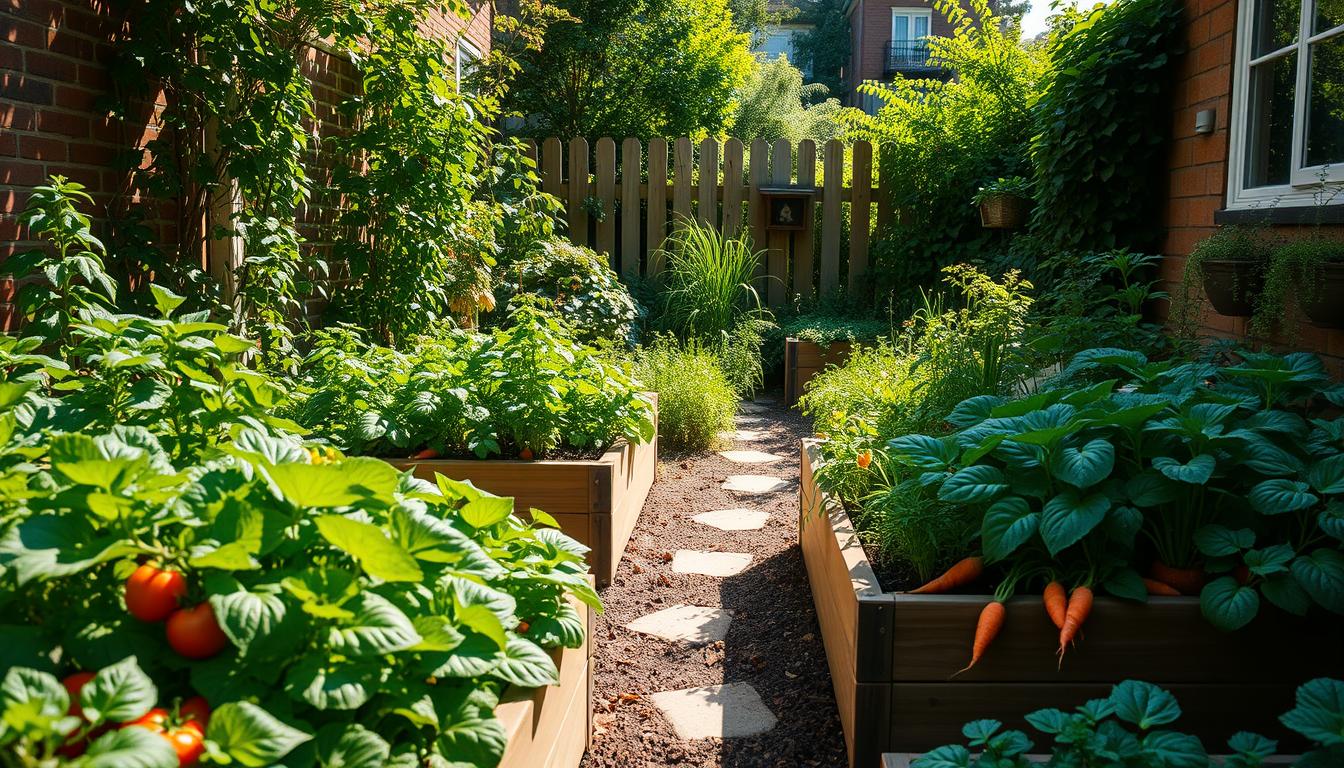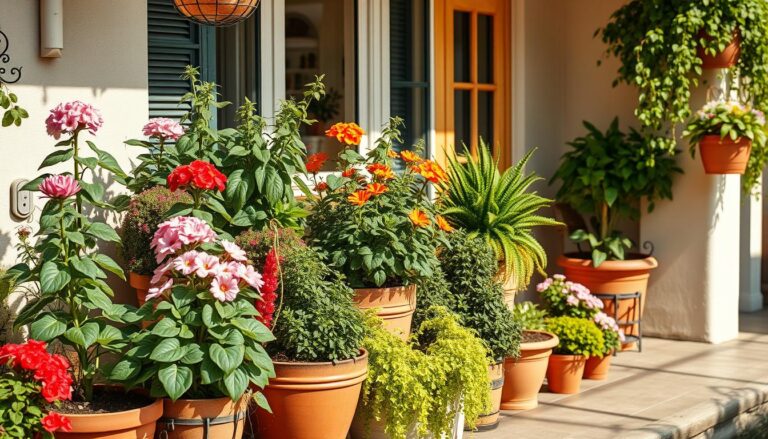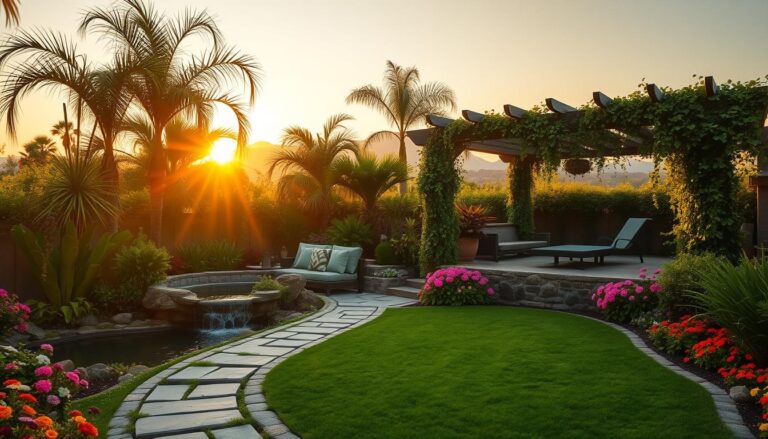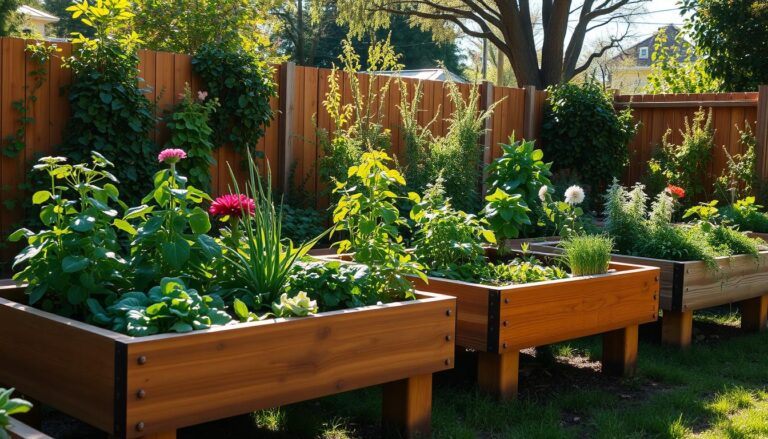Grow Big in a Small Space: Stunning Small Space Gardening
This post contains affiliate links, meaning I may receive a small commission if you make a purchase through my links, at no extra cost to you.
Imagine turning your limited outdoor space into a lush oasis. It can be full of life and vibrant colors. You don’t need a big backyard to grow your favorite herbs, vegetables, or flowers. With a bit of creativity and the right techniques, you can make a stunning garden in even the smallest spaces.
You can make a balcony, patio, or even a windowsill into a thriving garden. By using vertical gardening and other space-saving techniques, you can grow many plants. From leafy greens to juicy tomatoes, the possibilities are endless. In this article, we’ll show you the benefits and potential of small space gardening. We’ll give you expert-approved ideas and inspiration to start your own.
Key Takeaways
- Discover the benefits of small space gardening
- Learn expert-approved techniques for maximizing your space
- Explore creative ideas for growing a variety of plants
- Get inspired to start your own small space garden
- Find out how to turn any space into a thriving oasis
1. The Benefits of Small Space Gardening
Small space gardening offers many advantages, like growing your own food and boosting your mood. It lets people create their ownDiy Garden Projects, even in busy cities.
Why Small Space Gardening?
It’s perfect for city dwellers with little space. You can grow your ownSmall Veggie Garden Ideasand enjoy fresh food at home. It also encourages using recycled materials for gardening, making it aRecycled Gardenfriendly choice.
Connecting with Nature in Urban Areas
Gardening in small spaces lets you connect with nature, even in the city. Creating aSmall Space Vegetable Garden brings you joy and helps your mental health.
Environmental Benefits of Gardening
It’s also good for the planet. Growing your own food cuts down on industrial farming and transportation, lowering carbon emissions. Plus, it cleans the air and boosts urban biodiversity.
| Benefits | Description |
|---|---|
| Mental Well-being | Reduces stress and improves mental health |
| Fresh Produce | Allows you to grow your own fruits and vegetables |
| Sustainable Lifestyle | Promotes eco-friendly practices and reduces carbon footprint |
Small space gardening brings many benefits, from better mental health to a greener lifestyle.
2. Assessing Your Available Space
It’s important to check how much space you have for gardening. You might have a small balcony, patio, or rooftop. Knowing your space well is key for a successful garden.
Balconies, Patios, and Rooftops
Balconies, patios, and rooftops are great for small gardens. They can be turned into beautiful gardens, even in busy cities. Think about your space’s size and layout, and any challenges you might face.
For balconies, consider the weight and wind. Patios and rooftops might need more sunlight and good drainage. Knowing these details helps you plan a garden that fits your space perfectly.

Indoor vs. Outdoor Spaces
Decide if you want to garden indoors or outdoors. Indoor gardening is good for small spaces and can make your home green. Outdoor gardening lets you enjoy sunlight and fresh air.
Think about your space’s sunlight, temperature, and humidity. Choosing the right gardening type for your space ensures a beautiful garden.
Understanding Sunlight Exposure
Sunlight is crucial for your garden’s success. Most plants need 4-6 hours of direct sunlight daily. Some can handle shade or partial shade.
Watch your space during the day to see how much sunlight it gets. You can also use a sunlight meter or ask a gardening expert. Knowing your sunlight helps pick the right plants for a healthy garden.
3. Choosing the Right Plants
The key to a thriving small space garden is picking the right plants. Whether it’s a tiny balcony, a compact patio, or a small backyard, the plants you choose matter a lot. They will make your garden beautiful and functional.
Best Plants for Small Spaces
For small space gardening, choose plants that are compact and easy to care for. Herbs like basil and mint, leafy greens like lettuce and kale, and flowering plants like petunias and geraniums are great. They’re perfect for small spaces and add beauty and freshness.
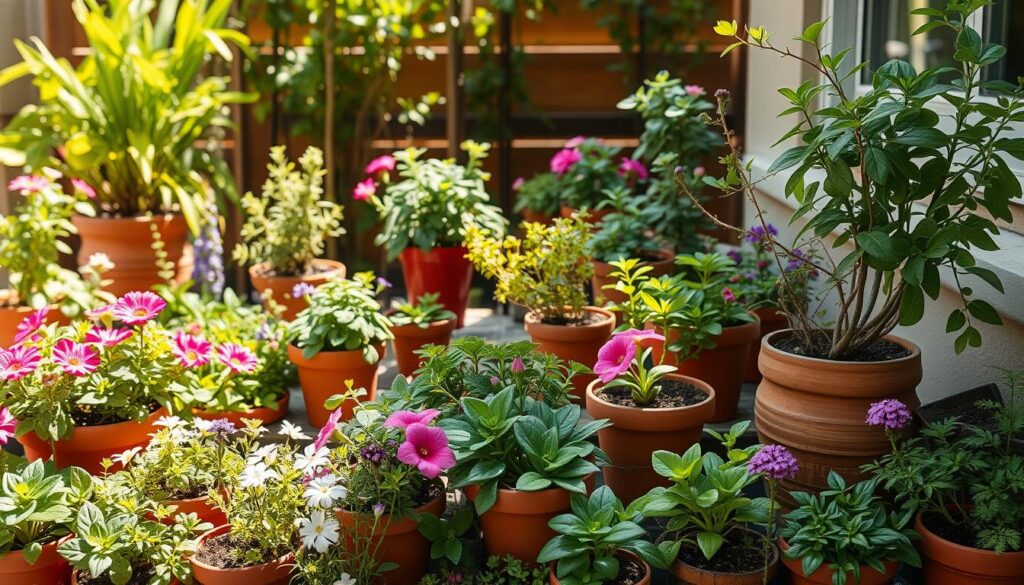
Edible vs. Ornamental
When picking plants for your small space garden, decide between edible and ornamental plants. Edible plants like vegetables, fruits, and herbs give you a delicious harvest. Ornamental plants like flowers and shrubs add beauty and interest. You can mix both for a diverse and thriving garden.
| Plant Type | Examples | Benefits |
|---|---|---|
| Edible | Tomatoes, Cucumbers, Herbs | Provides fresh produce, nutritious, and delicious |
| Ornamental | Petunias, Geraniums, Succulents | Adds beauty, visual interest, and attracts pollinators |
| Combination | Mix of edible and ornamental plants | Creates a diverse and thriving garden ecosystem |
Considerations for Vertical Gardening
Vertical gardening is great for small spaces. Choose plants that climb or trail, like peas, beans, and ivy. Use trellises, arbors, and wall-mounted planters to support your plants and add interest.
By picking the right plants and using creative gardening, you can make a beautiful small space garden. It will meet your needs and be a peaceful oasis in the city.
4. Container Gardening Essentials
Container gardening is perfect for small spaces. It lets you grow a beautiful garden in tiny backyards or on small patios.
Selecting the Right Containers
Picking the right containers is key for a successful garden. Think about the size, material, and drainage. Terracotta pots are popular but dry out fast. Plastic containers hold moisture better. Make sure they have holes for water to drain.
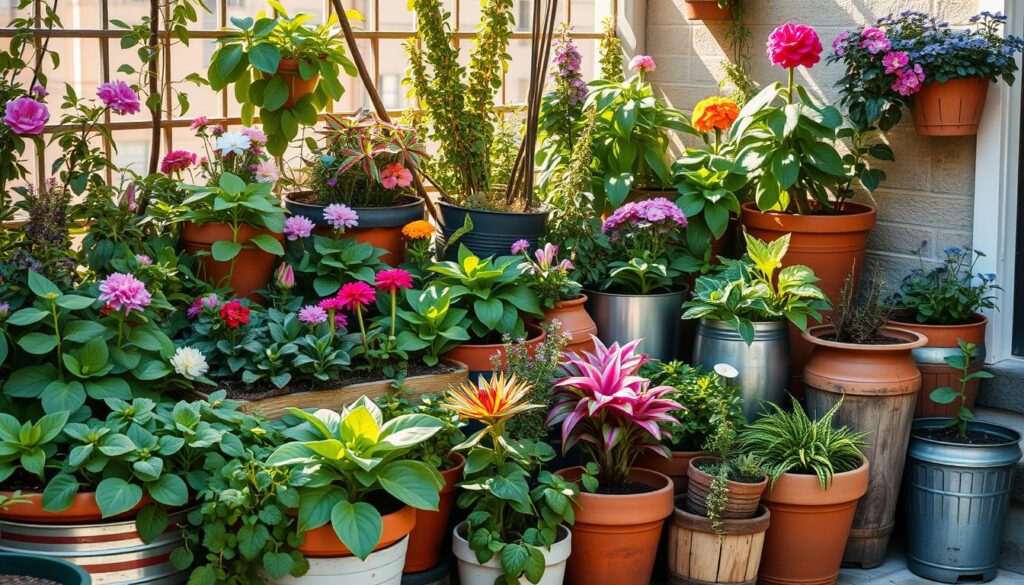
Soil and Drainage Tips
The soil in your containers is as important as the containers. Use a mix that drains well to avoid root rot. Adding compost can make the soil richer. For better drainage, put small rocks or broken pottery at the bottom.
| Container Material | Drainage Characteristics | Moisture Retention |
|---|---|---|
| Terracotta | Good drainage | Low moisture retention |
| Plastic | Variable drainage | High moisture retention |
| Wood | Good drainage | Medium moisture retention |
Creative Container Ideas
Think beyond traditional pots. Use old boots, wooden crates, or hanging baskets as planters. Self-watering planters can make care easier. For a small garden, get creative with your containers.
For a budget-friendly garden, use recycled items like pallets or barrels. You can also build a vertical garden on a trellis or wall. The most important thing is to have fun and be creative.
5. Vertical Gardening Techniques
Vertical gardening can change the game for city gardeners. It uses walls, trellises, and more to grow lush gardens in tight spots.
Wall Planters and Trellises
Wall planters and trellises are great for vertical gardening. They use wall space, adding beauty and keeping plants neat. Pick the right one based on your plants and sunlight.
Benefits of Wall Planters:
- Maximizes space
- Adds aesthetic appeal
- Can be used for a variety of plants
Trellises are perfect for climbing plants like ivy or clematis. They add beauty and create privacy and shade.
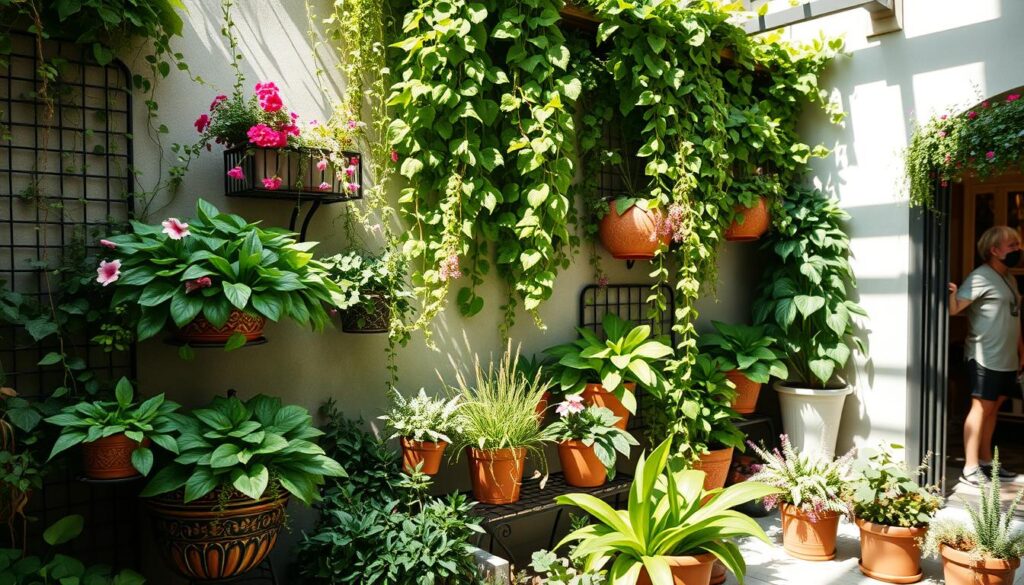
Hanging Gardens for Small Spaces
Hanging gardens are great for small areas. They hang plants from hooks or beams, adding beauty and depth. They’re perfect for balconies or patios.
Tips for Creating a Hanging Garden:
- Choose plants that thrive in hanging baskets, such as ferns or flowering plants.
- Ensure the hanging basket is securely attached to prevent it from swaying or falling.
- Water and fertilize your hanging garden regularly to keep it healthy and thriving.
Utilizing Stacked Planters
Stacked planters save space and are versatile. They stack to create a layered garden for herbs, succulents, or small plants.
When using stacked planters, choose plants with similar growing conditions to simplify care. Regular watering and fertilizing keep your garden alive.
Using these vertical gardening methods, you can make a beautiful, thriving garden in any small space. It brings joy and peace to your outdoor or indoor area.
6. Maximizing Vertical Space
You can make a stunning garden in a small space by using vertical gardening. This method lets you grow many plants, like flowers and veggies, without using much floor space.
Shelving Units for Plants
Using shelving units for plants is a smart way to use vertical space. These units can go on a wall or in a corner. They give lots of room for many plants. When picking a shelving unit, think about the material, size, and drainage to meet your plants’ needs.
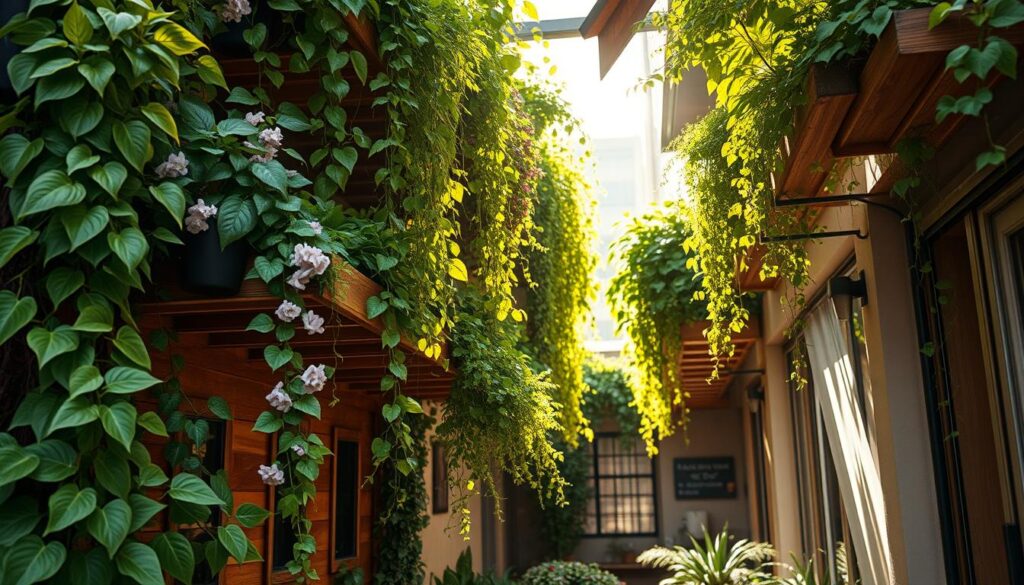
Using Ladders and Racks
Ladders and racks are also good for using vertical space. They can hold climbing plants or show off potted plants. Choose sturdy, weather-resistant materials for your ladder or rack.
Planting on Rails and Fences
Planting on rails and fences is a creative idea. You can train climbing plants to grow on them, making your garden look nice. Pick plants that get enough sunlight for your rail or fence.
These vertical gardening tips can turn even the smallest space into a beautiful garden. Whether you have a tiny balcony, patio, or courtyard, using vertical space can help you reach your gardening dreams.
7. Efficient Watering Solutions
Watering your small garden well is crucial. There are many ways to do this efficiently. We’ll look at three effective methods to keep your plants healthy.
Drip Irrigation Systems
Drip irrigation systems save water and keep plants hydrated. They deliver water right to the roots, cutting down on evaporation and runoff. This method can save up to 50% of water compared to traditional methods.
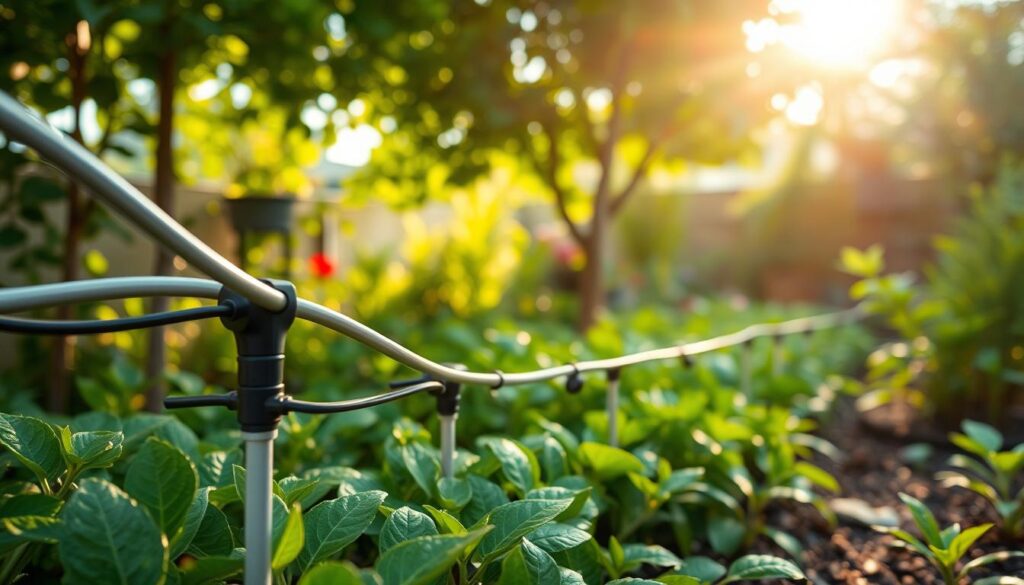
To set up a drip irrigation system, you need a kit with tubes, drippers, and a controller. You can adjust it to fit your garden, making sure each plant gets the right amount of water.
Self-Watering Planters
Self-watering planters are great for small gardens. They have a water reservoir that feeds plants as needed, cutting down on watering. They’re perfect for those who often forget to water.
“Self-watering planters are a game-changer for small space gardening. They take the guesswork out of watering and ensure that your plants receive the right amount of moisture.”
When picking self-watering planters, look for ones with a big water reservoir and good drainage. This prevents the soil from getting too wet.
Rainwater Collection Methods
Collecting rainwater is a smart way to save water and use natural resources. It lets you water your plants with clean, chemical-free water.
| Rainwater Collection Method | Benefits |
|---|---|
| Rain Barrels | Easy to install, cost-effective |
| Rainwater Harvesting Systems | Large storage capacity, customizable |
To start collecting rainwater, you can use a simple rain barrel or a more complex system. Either way, you’ll use less water and make your garden more sustainable.
8. Gardening Accessories for Small Spaces
You can make your small space garden better with the right accessories. Gardening in tight spots needs creativity and the right tools. Whether it’s a balcony, patio, or small backyard, the right tools can really help.
Compact Tools for Gardeners
Compact tools are key for small space gardening. They save space and make gardening easier. Here are some essential tools:
- Pruning shears for trimming plants
- A compact watering can or spray bottle
- A small trowel or cultivator for soil preparation
These tools are not just useful. They also help keep your garden tidy without taking up too much room.
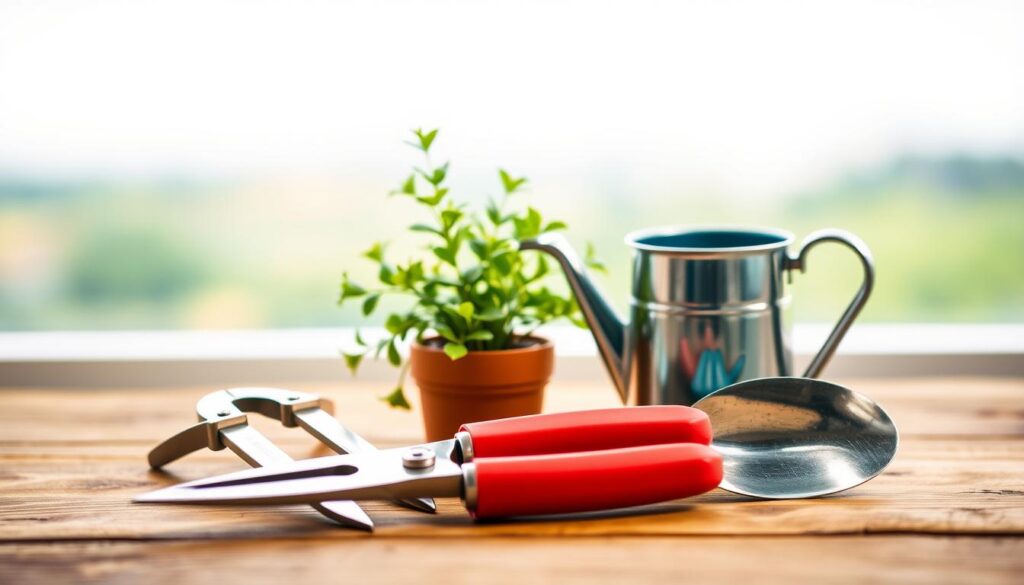
Grow Lights for Indoor Gardens
Grow lights are a big help for indoor gardens. They give plants the light they need, even in dim places. Think about the plants you have and how much space you have when picking grow lights.
LED grow lights are a good choice because they use less energy and don’t get too hot. Fluorescent lights are also popular for indoor gardening.
Decorative yet Functional Planters
Planters do more than hold plants; they add style to your garden. Pick planters that match your garden’s look and are practical.
| Planter Type | Description | Benefits |
|---|---|---|
| Terracotta Planters | Made from natural clay, these planters are breathable and allow for healthy root growth. | Good drainage, aesthetically pleasing |
| Self-Watering Planters | These planters have a built-in water reservoir, reducing the need for frequent watering. | Water conservation, reduced maintenance |
Adding these gardening accessories to your small space garden can make it flourish and look great. Whether you’re into Small Vegetable Garden Ideas or Diy Garden Projects, the right tools can help you succeed.
9. Seasonal Gardening Tips
As the seasons change, your small space garden needs adjustments to thrive. Knowing the seasonal gardening tips helps you use your space well. This is true for both a Small Space Vegetable Garden and a Recycled Garden.
Planting for Each Season
Different seasons mean different planting times. In spring, plant cool-season crops like lettuce and spinach. Summer is best for warm-season crops like tomatoes and peppers. In fall, plant cool-season crops again. Winter is for hardy vegetables like kale.
For a Tiny Garden Ideas On A Budget, use recycled materials for planters.

Seasonal Care and Maintenance
Seasonal care is key for a healthy garden. In spring, prune and fertilize. Summer needs regular watering and pest control. In fall, clean up and prepare for next year.
Winter is for planning and preparing. Use drip irrigation systems to save water and reduce work.
Extending the Growing Season
To grow longer, use cold frames, hoop houses, or row covers. These protect plants from harsh weather. Grow lights can also help in winter.
By following these tips, your small garden can thrive. Whether you’re new or experienced, these tips help you enjoy gardening.
10. Finding Inspiration for Your Garden
As you grow your small space garden, staying inspired is key. Look for inspiration in community gardens, online, and through books.
Community gardens are great for seeing what’s possible in small areas. You can meet other gardeners and learn from them. Online, social media and gardening sites offer new techniques and trends.
Books and magazines on small gardens can give you detailed advice. They help you create a unique garden in your small space.
By exploring these sources, you can keep enjoying your small garden. You’ll make the most of your space and enjoy the benefits of gardening.
FAQ
What are some small space gardening ideas for urban areas?
For urban areas, think about vertical gardening, container gardening, or a small herb garden. You can also use indoor spaces with grow lights and self-watering planters.
How do I assess the available space for gardening in my small yard or balcony?
To find out your space, measure it and check the sunlight and weather. Decide if you’ll garden indoors or outdoors.
What are the best plants for small space gardening?
Great plants for small spaces include leafy greens, cherry tomatoes, and herbs. Also, consider flowering plants like petunias and begonias. Succulents and air plants are good for easy care.
How do I choose the right containers for my small space garden?
Choose containers based on size, material, and drainage. Use plastic, clay, or wood, and make sure they drain well to avoid soggy soil.
What are some efficient watering solutions for small space gardening?
For efficient watering, try drip irrigation, self-watering planters, or collecting rainwater. These methods save water and keep your garden healthy.
How can I maximize my vertical space for gardening?
To use vertical space, try shelving, ladders, and racks. Plant on rails and fences, or use wall planters and trellises.
What are some seasonal gardening tips for small space gardens?
Plant seasonal flowers and veggies, and adjust care based on the season. Use succession planting and crop rotation to grow more.
Where can I find inspiration for my small space garden?
For inspiration, visit community gardens, check online, or read books and magazines. These sources offer many ideas for your garden.

